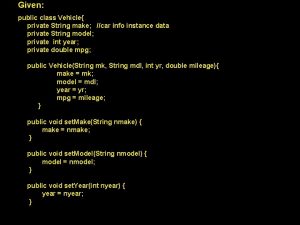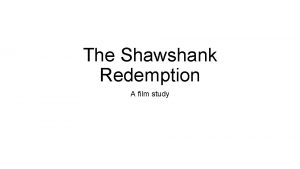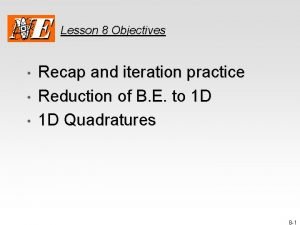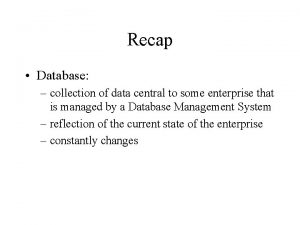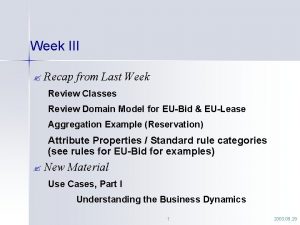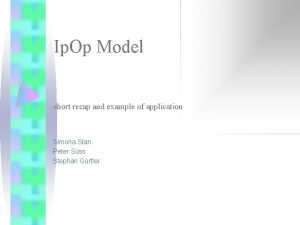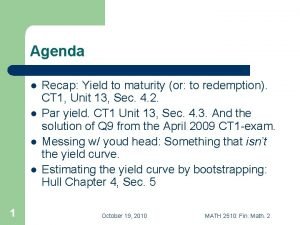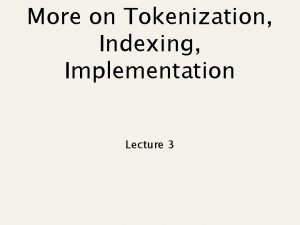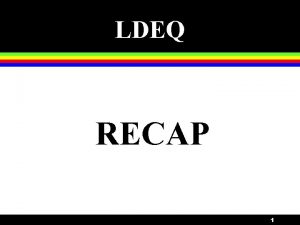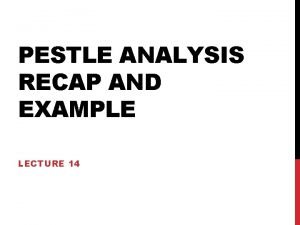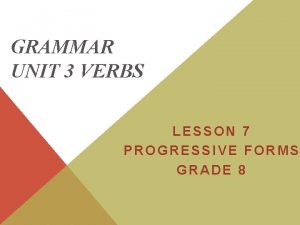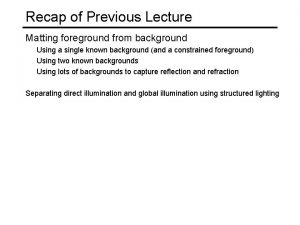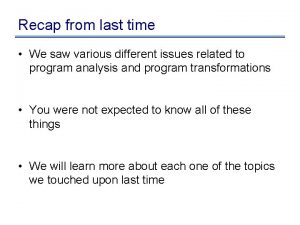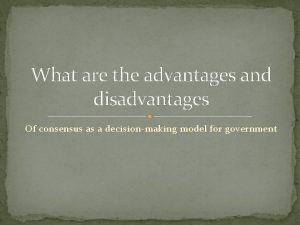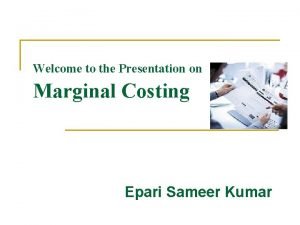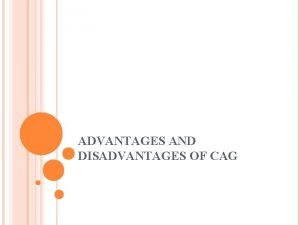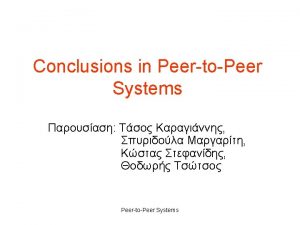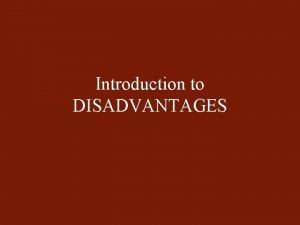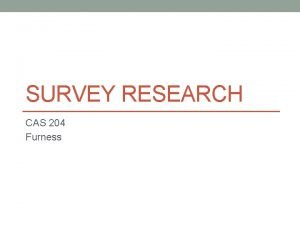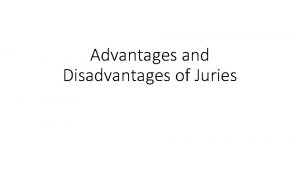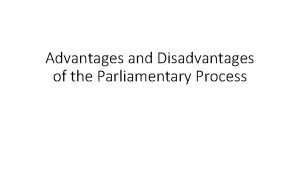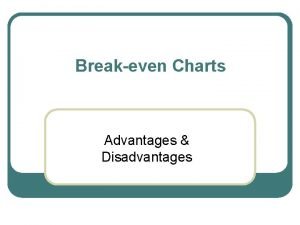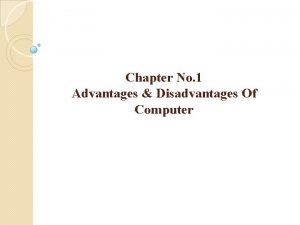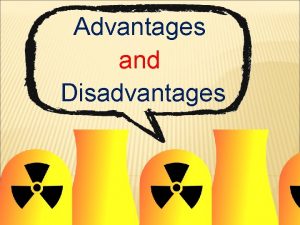Recap Vehicle Leasing Advantages of Commercial Leasing Disadvantages





















































- Slides: 53

Recap • Vehicle Leasing • Advantages of Commercial Leasing • Disadvantages of Commercial Leasing • The Leasing Sector in Pakistan • Leasing as Investment Indicator • Leasing as working capital • Economic Cost of Leasing

Lecture # 35 Insurance Companies

• Insurance, in law and economics, is a form of risk management primarily used to hedge against the risk of a contingent loss. Insurance is defined as the equitable transfer of the risk of a loss, from one entity to another, in exchange for a premium.

• Insurer, in economics, is the company that sells the insurance. Insurance rate is a factor used to determine the amount, called the premium, to be charged for a certain amount of insurance coverage. Risk management, the practice of appraising and controlling risk, has evolved as a discrete field of study and practice.

Principles of Insurance

1. A large number of homogeneous exposure units. The vast majority of insurance policies are provided for individual members of very large classes. Automobile insurance, for example, covered about 175 million automobiles in the United States in 2004

The existence of a large number of homogeneous exposure units allows insurers to benefit from the so-called “law of large numbers, ” which in effect states that as the number of exposure units increases, the actual results are increasingly likely to become close to expected results. There are exceptions to this criterion.

Lloyd's of London is famous for insuring the life or health of actors, actresses and sports figures. Satellite Launch insurance covers events that are infrequent. Large commercial property policies may insure exceptional properties for which there are no ‘homogeneous’ exposure units.

• Despite failing on this criterion, many exposures like these are generally considered to be insurable.

Definite Loss. The event that gives rise to the loss that is subject to insurance should, at least in principle, take place at a known time, in a known place, and from a known cause. The classic example is death of an insured on a life insurance policy.

• Fire, automobile accidents, and worker injuries may all easily meet this criterion. Other types of losses may only be definite in theory.

Occupational disease, for instance, may involve prolonged exposure to injurious conditions where no specific time, place or cause is identifiable. Ideally, the time, place and cause of a loss should be clear enough that a reasonable person, with sufficient information, could objectively verify all three elements.

Accidental Loss. The event that constitutes the trigger of a claim should be fortuitous, or at least outside the control of the beneficiary of the insurance. The loss should be ‘pure, ’ in the sense that it results from an event for which there is only the opportunity for cost. And

• Events that contain speculative elements, such as ordinary business risks, are generally not considered insurable.

Large Loss. The size of the loss must be meaningful from the perspective of the insured. Insurance premiums need to cover both the expected cost of losses, plus the cost of issuing and administering the policy, adjusting losses, and

supplying the capital needed to reasonably assure that the insurer will be able to pay claims. For small losses these latter costs may be several times the size of the expected cost of losses. There is little point in paying such costs unless the protection offered has real value to a buyer.

Affordable Premium. If the likelihood of an insured event is so high, or the cost of the event so large, that the resulting premium is large relative to the amount of protection offered, it is not likely that anyone will buy insurance, even if on offer.

Further, as the accounting profession formally recognizes in financial accounting standards the premium cannot be so large that there is not a reasonable chance of a significant loss to the insurer. If there is no such chance of loss, the transaction may have the form of insurance, but not the substance.

Calculable Loss. There are two elements that must be at least estimable, if not formally calculable: the probability of loss, and the attendant cost. Probability of loss is generally an empirical exercise, while cost has more to do with the ability of a reasonable person in possession of a copy of the insurance policy and

• a proof of loss associated with a claim presented under that policy to make a reasonably definite and objective evaluation of the amount of the loss recoverable as a result of the claim.

Limited risk of catastrophically large losses. The essential risk is often aggregation. If the same event can cause losses to numerous policyholders of the same insurer, the ability of that

insurer to issue policies becomes constrained, not by factors surrounding the individual characteristics of a given policyholder,

but by the factors surrounding the sum of all policyholders so exposed. Typically, insurers prefer to limit their exposure to a loss from a single event to some small portion of their capital base, on the order of 5 percent.

Where the loss can be aggregated, or an individual policy could produce exceptionally large claims, the capital constraint will restrict an insurers appetite for additional policyholders.

The classic example is earthquake insurance, where the ability of an underwriter to issue a new policy depends on the number and size of the policies that it has already underwritten. Wind insurance in hurricane zones, particularly along coast lines, is another example of this phenomenon

In extreme cases, the aggregation can affect the entire industry, since the combined capital of insurers and re-insurers can be small compared to the needs of potential policyholders in areas exposed to aggregation risk.

In commercial fire insurance it is possible to find single properties whose total exposed value is well in excess of any individual insurer’s capital constraint. Such properties are generally shared among several insurers, or are insured by a single insurer who syndicates the risk into the reinsurance market.

Insurance Policy

• The benefit provided by a particular kind of indemnity contract, called an insurance policy; • That is issued by one of several kinds of legal entities (stock insurance company, mutual insurance company, reciprocal, for example), any of which may be called an insurer;

• in which the insurer promises to pay on behalf of or to indemnify another party, called a policyholder or insured; • that protects the insured against loss caused by those perils subject to the indemnity in exchange for consideration known as an insurance premium.

• In recent years this kind of operational definition proved inadequate as a result of contracts that had the form but not the substance of insurance. The essence of insurance is the transfer of risk from the insured to one or more insurers. How much risk a contract actually transfers proved to be at the heart of the controversy.

• This issue arose most clearly in reinsurance, where the use of Financial Reinsurance to reengineer insurer balance sheets under US GAAP became fashionable during the 1980 s. The accounting profession raised serious concerns about the use of reinsurance in which little if any actual risk was transferred, and

• went on to address the issue in FAS 113, cited above. While on its face, FAS 113 is limited to accounting for reinsurance transactions, the guidance it contains is generally conceded to be equally applicable to US GAAP accounting for insurance transactions executed by commercial enterprises.

Risk Limiting Features

• An insurance policy should not contain provisions that allow one side or the other to unilaterally void the contract in exchange for benefit. Provisions that void the contract for failure to perform or fraud or material misrepresentation are ordinary and acceptable.

• The policy should have a term of not more than about three years. This is not a hard and fast rule. Contracts of over five years duration are classified as ‘longterm, ’ which can impact the accounting treatment, and can obviously introduce the possibility that over the entire term of the contract, no actual risk will transfer.

• The coverage provided by the contract need not cease at the end of the term (e. g. , the contract can cover occurrences as opposed to claims made or claims paid).

• The contract should be considered to include any other agreements, written or oral, that confer rights, create obligations, or create benefits on the part of either or both parties. Ideally, the contract should contain an ‘Entire Agreement’ clause that assures there are

• no undisclosed written or oral side agreements that confer rights, create obligations, or create benefits on the part of either or both parties. If such rights, obligations or benefits exist, they must be factored into the tests of reasonableness and significance.

• The contract should not contain arbitrary limitations on timing of payments. Provisions that assure both parties of time to properly present and consider claims are acceptable provided they are commercially reasonable and customary.

• Provisions that expressly create actual or notional accounts that accrue actual or notional interest suggest that the contract contains, in fact, a deposit.

• Provisions for additional or return premium do not, in and of themselves, render a contract something other than insurance. However, it should be unlikely that either a return or additional premium provision be triggered, and neither party should have discretion regarding the timing of such triggering.

Gambling Analogy

• Gambling transactions offer the possibility of either a loss or a gain. Gambling creates losers and winners. Insurance transactions do not present the possibility of gain. Insurance offers financial support sufficient to replace loss, not to create pure gain.

• Gamblers can continue spending, buying more risk than they can afford to pay for. Insurance buyers can only spend up to the limit of what carriers would accept to insure; their loss is limited to the amount of the premium.

• Gambling or gaming is designed at the start so that the odds are not affected by the players' conduct or behavior and not required to conduct risk mitigation practices. But players can prepare and increase their odds of winning in certain games such as poker or blackjack.

• In contrast to gambling or gaming, to obtain certain types of insurance, such as fire insurance, policyholders can be required to conduct risk mitigation practices, such as installing sprinklers and using fireproof building materials to reduce the odds of loss to fire.

• In addition, after a proven loss, insurers specialize in providing rehabilitation to minimize the total loss.

Types of Insurance

• Any risk that can be quantified can potentially be insured. Specific kinds of risk that may give rise to claims are known as "perils". An insurance policy will set out in detail which perils are covered by the policy and which are not.

• Now there is a (non-exhaustive) list of the many different types of insurance that exist. A single policy may cover risks in one or more of the categories set forth below.

• For example, auto insurance would typically cover both property risk (covering the risk of theft or damage to the car) and liability risk (covering legal claims from causing an accident).

Recap • • • Principles of Insurance Policy Risk Limiting Features Gambling Analogy Types of Insurance 1. Homeowner's insurance 2. Aviation insurance 3. Business insurance 4. Casualty insurance 5. Crime insurance
 Vehicle rental software solutions
Vehicle rental software solutions Gsa drive through
Gsa drive through Commercial and noncommercial food service operations
Commercial and noncommercial food service operations Ipes certified carriers
Ipes certified carriers Commercial vehicle
Commercial vehicle Travelling is very popular nowadays.
Travelling is very popular nowadays. Commercial vehicle production
Commercial vehicle production Public class mycar
Public class mycar Disadvantages of commercial banks
Disadvantages of commercial banks The shawshank redemption movie summary
The shawshank redemption movie summary Summary chapter 8 the great gatsby
Summary chapter 8 the great gatsby Price is right recap
Price is right recap What is the purpose of an iteration recap
What is the purpose of an iteration recap Recap intensity clipping
Recap intensity clipping 60 minutes recap
60 minutes recap Recap database
Recap database Differentiation recap
Differentiation recap Introduction for recap
Introduction for recap Recap introduction
Recap introduction Recap from last week
Recap from last week Socratic seminar questions for the crucible act 1
Socratic seminar questions for the crucible act 1 Pontius pilate allusion
Pontius pilate allusion Logbook recap example
Logbook recap example Ytm recap
Ytm recap Black box recap
Black box recap Fractions recap
Fractions recap Recap
Recap Recap coordinate system
Recap coordinate system Recap indexing scans
Recap indexing scans Lets recap
Lets recap Recap poster
Recap poster What is an essay
What is an essay Ldeq recap
Ldeq recap Romeo and juliet act 1 summary
Romeo and juliet act 1 summary Recap accounting
Recap accounting Example of recap
Example of recap Let's recap
Let's recap Perfect lesson 7
Perfect lesson 7 Two trait punnett square
Two trait punnett square Recap background
Recap background Realism vs anti realism
Realism vs anti realism Saw recap
Saw recap Briefly recap
Briefly recap Advantages of zinc sulphate flotation technique
Advantages of zinc sulphate flotation technique Essay discussing advantages and disadvantages
Essay discussing advantages and disadvantages How to start a advantage and disadvantage essay
How to start a advantage and disadvantage essay Nucleated settlement advantages and disadvantages
Nucleated settlement advantages and disadvantages Fermenter
Fermenter Disadvantages of consensus communication
Disadvantages of consensus communication Advantages of marginal costing
Advantages of marginal costing Advantages and disadvantages of weeds
Advantages and disadvantages of weeds Advantages and disadvantages of dams
Advantages and disadvantages of dams Advantages and disadvantages of warm up
Advantages and disadvantages of warm up Phase contrast microscopy advantages and disadvantages
Phase contrast microscopy advantages and disadvantages







